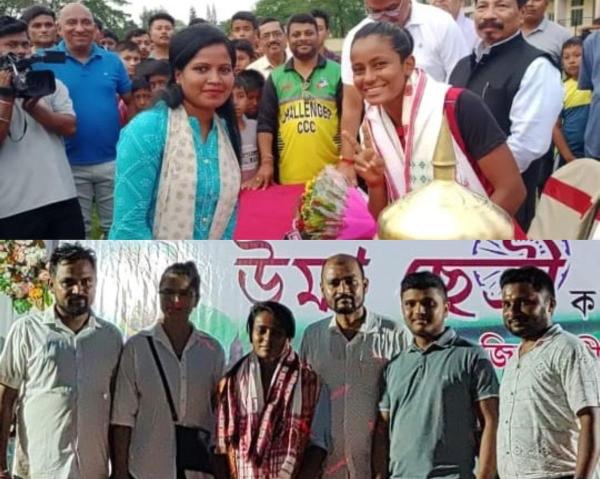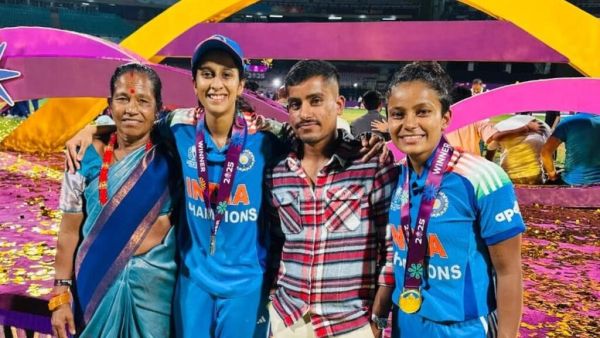When Dipa Chetry had gone to watch her daughter Uma play for India in its opening match at the Women’s ODI World Cup on September 30, she’d met captain Harmanpreet Kaur at the Barsapara Stadium in Guwahati.
“I spoke to the coaches and even told Harmanrpeet Kaur that she must keep the World Cup home,” Dipa tells Sports stars.
And Harmanpreet did keep it home.
On Sunday, India beat South Africa in the final to claim its maiden World Cup title. While Dipa couldn’t watch Uma make her debut that day in Guwahati, she was in Navi Mumbai at the DY Patil Stadium to see her daughter get the winner’s medal at the presentation ceremony.
Uma’s maiden ODI World Cup call-up was quite last-minute – she came in as an injury replacement for Yastika Bhatia – and the wicketkeeper was called into action mid-game during the must-win match against New Zealand, replacing an injured Richa Ghosh behind the stumps.
Three days later, she was handed her maiden ODI cap by Smriti Mandhana ahead of the side’s final league stage fixture against Bangladesh.
Uma Chetry was handed her maiden ODI cap ahead of India’s final league stage fixture against Bangladesh.
| Photo Credit:
EMMANUAL YOGINI
Uma Chetry was handed her maiden ODI cap ahead of India’s final league stage fixture against Bangladesh.
| Photo Credit:
EMMANUAL YOGINI
Early struggles
According to her childhood coach Mahboob Alam, who’s watched Uma grow up, there have been “zero” changes in his ward. “Even today if you come to our town, you’ll see that she’s still so down to earth. You know the amount of money that there is in Indian cricket. People can get distracted after that but Uma has always maintained discipline and stayed humble.”
Uma, the youngest of five siblings, hails from the Kandhulimari village – which still floods a few times a year – roughly 10 km away from the Bokakhat district of Assam. When she was three, her tryst with cricket began with a plastic bat and ball which was bought from a Durga Puja pandal.
After playing with boys in her neighbourhood, she went on to train at the Bokakhat local ground, where Alam and Raja Rahman used to coach kids. “She would wear slippers and come walking to attend the Bokhakhat Hindi High School near the ground, they didn’t have the money to afford equipment. She would make do with whatever we could provide at the academy,” Alam, who also runs a bakery, remembers first watching a young Uma train at his Bokhakhat Town Cricket Club academy.
Uma had her family’s support when she began playing at a young age, but circumstances back home weren’t ideal. Their livelihood was majorly dependent on farming and since all the five children were in school at that time, things weren’t great financially.
“My only thought was that a girl can do anything a boy can. I wanted her to play,” Dipa looks back at her reaction when her daughter decided to pursue sport.
Slowly, Uma began making inroads into the State’s age-level teams. However, poor returns meant that she was dropped during the 2016-17 season. “She told me she wanted to train full-time with me. I told her ‘you will have to follow my rules’ and she agreed. She would reach the ground by 5:30 am after finishing her farming work and manage training along with her school,” Alam adds.
Reaping rewards
After sharpening her skills, playing for Assam, and once even losing her shoes in a flood, Uma broke through the India A ranks when she was called up for the 2023 ACC Women’s T20 Emerging Teams Asia Cup.
On returning home after winning the tournament with India, Uma received a warm welcome. “We had a rally for her from her house to our local ground in Bokakhat. People from different clubs, societies, and well-wishers blessed her and felicitated her with Assam’s Phulam Gamusa (traditional woven scarf),” Alam reminisces.

Grand welcome: Uma is seen being felicitated throughout a rally organised by her close ones after she returned from a successful campaign at the 2023 ACC Women’s T20 Emerging Teams Asia Cup.
| Photo Credit:
Special Arrangement
Grand welcome: Uma is seen being felicitated throughout a rally organised by her close ones after she returned from a successful campaign at the 2023 ACC Women’s T20 Emerging Teams Asia Cup.
| Photo Credit:
Special Arrangement
After coming back from the India A stint in Hong Kong, Uma gifted Alam a few good-quality nets for his academy, the coach reveals, perhaps a token of gratitude for receiving years of coaching for free.
Uma continued to be part of India’s T20 set-up – she was in India’s Asian Games squad in 2023. Last year, months after she was brought in by UP Warriorz as an injury replacement for Vrinda Dinesh in the Women’s Premier League, the Assam wicketkeeper-batter was handed her maiden T20I debut against South Africa in Chennai.
After playing a couple of WPL seasons and being part of BCCI’s Annual Contracts as a Grade C player this past year, Uma has helped in allaying her family’s financial malaise.
“Even today, we continue to farm but that’s only to sustain ourselves, not for selling. Be it grains or vegetables, we use them. Our annual household income comes to around a lakh and a half,” says one of Uma’s elder brother Bijoy, who couldn’t travel to Navi Mumbai for the final because of harvest time. The other brothers in the family earn their livelihood through masonry work, working in a hardware store, and driving a rickshaw.
She has also helped with medical expenses for her father, Lok Bahadur Chetry, a farmer who suffers from high blood pressure and sugar levels.
Uma, the inspiration
Dr. Manju C. Das, a former Assam cricketer between 1989 and 2001 who is currently a Level 1 coach with the Assam Cricket Association (ACA), feels that women’s cricket was given a helping hand after the erstwhile Women’s Cricket Association of Assam was merged with ACA in 2006 when BCCI adopted the then Women’s Cricket Association of India (WCAI).
“We used to bear all expenses while representing our State. Once the association was merged with ACA and WCAI adopted by BCCI, there have been drastic changes in infrastructure and finance matters. Now everyone is looking towards her (Uma). Parents are also encouraging their daughters and even opting for open schooling where they can focus on playing as well as studies,” Manju explains.
She also credits the work ACA has done to promote the women’s game through provisions like providing free training to girls at district academies and incentives like giving Rs. 1000 every month to Under-15 girls playing district till they turn 15 or play for the State, whichever comes first. Manju’s own daughter is benefiting from this scheme.
Jintimani, who’s been with Mumbai Indians since the inaugural WPL edition, adds, “When both Uma and I played WPL, more girls in Assam started taking up cricket. I think since Uma started playing for India, more and more girls have been playing the sport.”
Around 2006, girls formally started playing cricket in Bokakhat and participating in district competitions. Alam and others had to call players to fill up teams. Nowadays, there are so many girls playing in the town that there could be four to five teams made with them, the happy coach expresses.
“Sometimes we even send some of the players to teams from other districts. Uma has certainly had a role to play in that (popularising cricket). Young girls from the town, around 15-20 of them, have joined the sport by getting inspired by her. In fact, many boys are also being influenced by her,” Alam says.
Uma might not have played in India’s historic final win, but her debut at this 50-over showpiece, and becoming the first player from the northeast to win the Women’s World Cup, has shown the steady rise of Assam women’s cricket and reinforced her role as its flag-bearer.
Published on Nov 04, 2025











